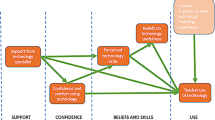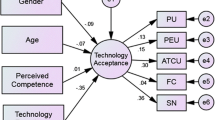Abstract
The purposes of this study were to explore the parents’ acceptance of participation in integration of technology into children’s instruction. The Technology Acceptance Model (TAM) was adopted as the framework in the study. There were 876 fifth-grader’s parents in Taipei, Taiwan participated in the study. The research results show that parents’ beliefs and parent–teacher communication can be used to directly and indirectly predict the perceived usefulness and perceived ease of use integration of information technology into instruction. The parents–child interactions can directly predict the perceived usefulness in TAM model and indirectly predict perceived ease of use. In the TAM model, the perceived ease of use and perceived usefulness could predict their attitude toward use and the intentions to use of the integration of technology into instruction for children. Finally, we discuss the implications of our findings for parents, teachers, and future studies.


Similar content being viewed by others
References
Alvarez, M., Torres, A., Rodriguez, E., Padilla, S., & Rodrigo, M. J. (2013). Attitudes and parenting dimensions in parents’ regulation of Internet use by primary and secondary school children. Computers & Education, 67, 69–78.
Bailey, L. B. (2006). Interactive homework: A tool for fostering parent-child interactions and improving learning outcomes for at-risk young children. Early Childhood Education Journal, 34(2), 155.
Ballantine, J. H. (1999). Getting involved in our children’s education. Childhood Education, 75(3), 170–171.
Baron, R. M., & Kenny, D. A. (1986). The moderator-mediator distinction in social psychological research: Conceptual, strategic, and statistical considerations. Journal of Personality and Social Psychology, 51(6), 1173–1182.
Blau, I., & Hameiri, M. (2012). Teacher-families online interactions and gender differences I parental involvement through school data system: Do mothers want to know more than fathers about their children? Computers & Education, 59, 701–709.
Boomsma, A. (1987). The robustness of maximum likelihood estimation in structural equation models. New York: Cambridge University Press.
Bryan, J., Burstein, K., & Bryan, T. (2001). Students with learning disabilities: Homework problems and promising practices. Educational Psychologist, 36(3), 167–180.
Cangur, S., & Ercan, I. (2015). Comparison of model fit indices used in structural equation modeling under multivariate normality. Journal of Modern Applied Statistical Methods, 14(1), 152–167.
Chao, R. K. (1994). Beyond parental control and authoritarian parenting style: Understanding Chinese parenting through the cultural notion of training. Child Development, 65, 1111–1120.
Chen, H. M., Yu, C., & Chang, C. S. (2007). E-homebook system: A web-based interactive education interface. Computers & Education, 49(2), 160–175.
Cranmer, S. (2006). Children and young people’s uses of the Internet for homework. Learning Media and Technology, 31, 301–315.
British Educational Communications and Technology Agency (BECTA) (2008). Harnessing technology: Next generation learning. 2008-2014. BECTA, Cobventry. Retrieved from https://www.becta.org.uk
Daniel, G. (2011). Family-school partnerships: Towards sustainable pedagogical practice. Asia-Pacific Journal of Teacher Education, 39, 165–176.
Davies, C. (2011). Digitally strategic: How young people respond to parental views about the use of technology for learning in the home. Journal of Computer Assisted Learning, 27, 324–335.
Davis, F. D. (1989). Perceived usefulness, perceived ease of use, and user acceptance of information technology. MIS Quarterly, 13(3), 319–340.
Davis, F. D., Bagozzi, R. P., & Warshaw, P. R. (1989). User acceptance of computer technology: A comparison of two theoretical models. Management Science, 35(8), 982–1003.
Desforges, C., & Abouchar, A. (2003). The impact of parent involvement, parent support and family education on pupil achievement: A literature review. Research Report RR433. Australia: Queen’s.
DfEE(1998). Homework: Guidelines for primary and secondary schools. London: DFEE Standards and Effectiveness Unit.
Epstein, J. L. (1992). School and family partnerships. In M. C. Alkin (Ed.), Encyclopedia of educational research (6th ed., pp. 1139–1151). New York: Macmillan.
Fay-Stammbach, T., Hawes, D. J., & Meredith, P. (2014). Parenting influences on executive function in early childhood: A review. Child Development Perspectives, 8(4), 258–264.
Fishbein, M., & Ajzen, I. (1975). Belief, attitude, intention, and behavior: An introduction to theory and research. Boston: Addison-Wesley.
Fleming, J., Greentree, S., Cocotti-Muller, D., Elias, K., & Morrison, S. (2006). Safety in cyberspace. Youth and Society, 38, 135–154.
Fornell, C., & Larcker, D. (1981). Evaluating structural equation models with unobservable variables and measurement error. Journal of Marketing Research, 18, 39–50.
Gong, M., Xu, Y., & Yu, Y. (2004). An enhanced technology acceptance model for web-based learning. Journal of Information Systems Education, 15(4), 365–374.
Ho, E. S., & Willms, J. D. (1996). Effects of parental involvement on eighth-grade achievement. Sociology of Education, 69, 126–141.
Ho, L., Hung, C., & Chen, H. (2013). Using theoretical models to examine the acceptance behavior of mobile phone messaging to enhance parent-teacher interactions. Computers & Education, 61, 105–114.
Hohlfeld, T. N., Ritzhaupt, A. D., & Barron, A. E. (2010). Connecting schools, community, and family with ICT: Four-year trends related to school level and SES of public schools in Florida. Computers & Education, 55(1), 391–405.
Hollingworth, S., Mansaray, A., Allen, K., & Rose, A. (2011). Parents’ perspectives on technology and children's learning in the home: Social class and the role of the habitus. Journal of Computer Assisted Learning, 27, 347–360.
Hoyle, R. H., & Panter, A. T. (1995). Writing about structural equation models. In R. H. Hoyle (Ed.), Structural equation modeling: Concepts, issues, and applications (pp. 158–176). Thousand Oaks, CA: Sage.
Hung, C.-L. (2008). A Research on willingness of parent-teacher Interaction through internet with TAM: A case study on JAPS. Unpublished masters’ theses, Yuan Ze University, Taiwan.
Hwang, W. Y., Liu, Y. F., Chen, H. R., Huang, J. W., & Li, J. Y. (2015). Role of parents and annotation sharing in children’s learning behavior and achievement using e-readers. Journal of Educational Technology & Society, 18, 292–307.
Jöreskog, K. G., & Sörbom, D.(1993). LISREL 8.5: A guide to the program and application. Chicago, IL: SPSS.
Kong, S. C. (2018). Parents’ perceptions of e-learning in school education: Implications for the partnership between schools and parents. Technology, Pedagogy and Education, 27(1), 15–31. https://doi.org/10.1080/1475939X.2017.1317659.
Kong, S. C., & Li, K. M. (2009). Collaboration between school and parents on fostering information literacy: Learning in the information society. Computers and Education, 52(2), 275–282.
Larsson, L. (2002). Digital literacy checklist. In H. Services (Ed.), Health Services. University of Washington, Washington.
Legrisa, P., Inghamb, J., & Collerettec, P. (2003). Why do people use information technology? A critical review of the technology acceptance model. Information & Management, 40, 191–204.
Lewin, C., & Luckin, R. (2010). Technology to support parental engagement in elementary education: Lessons learned from the UK. Computers and Education, 54(3), 749–758.
Li, C.-C., & Tung, C.-J. (2001). A highway of communication between teachers and parents-network homebook. Audio-Visual Education Bimonthly, 49(1), 26–33.
Lou, S. J., Shih, R. C., Liu, H. T., Guo, Y. C., & Tseng, K. H. (2010). The influences of the sixth graders' parents’ internet literacy and parenting style on internet parenting. Turkish Online Journal of Educational Technology-TOJET, 9(4), 173–184.
Lueder, D. C. (1998). Creating Partnerships with Parents: An educator’s guide. Lancaster, PA: Technomic Pub. Co.
Martinez-Torres, M., Toral Marín, S., Garcia, F., Vazquez, S., Oliva, M., & Torres, T. (2008). A technological acceptance of e-learning tools used in practical and laboratory teaching, according to the European higher education area. Behaviour & Information Technology, 27(6), 495–505.
Ngai, E. W. T., Poon, J. K. L., & Chan, Y. H. C. (2007). Empirical examination of the adoption of WebCT using TAM. Computers & Education, 48, 250–267.
Nunnally, J. C., & Bernstein, I. H. (1994). Psychometric theory (McGraw-Hill series in psychology). New York: McGraw-Hill.
Ofcom. (2014). The Communications Market Report. Retrieved March 19, 2015, from https://stakeholders.ofcom.org.uk/binaries/research/cmr/cmr14/2014_UK_CMR.pdf.
Olmstead, C. (2013). Using technology to increase parent involvement in schools. TechTrends, 57(6), 28–37.
Paiva, J. C., Morais, C., & Moreira, L. (2017). Activities with parents on the computer: An ecological framework. Educational Technology & Society, 20(2), 1–14.
Plowman, L., & McPake, J. (2013). Seven myths about young children and technology. Childhood Education, 89, 27–33.
Shin, W., & Li, B. (2017). Parental mediation of children’s digital technology use in Singapore. Journal of Children and Media, 11(1), 1–19.
Sonck, N., Nikken, P., & de Haan, J. (2013). Determinants of internet mediation: A comparison of the reports by Dutch parents and children. Journal of Children and Media, 7(1), 96–113.
Tam, V. C., & Chan, R. M. (2009). Parental involvement in primary children’s homework in Hong Kong. School Community Journal, 19(2), 81–100.
Teo, T., & Zhou, M. (2017). The influence of teachers’ conceptions of teaching and learning on their technology acceptance. Interactive Learning Environments, 25(4), 513–527. https://doi.org/10.1080/10494820.2016.1143844.
Turow, J., & Nir, L.(2000). The internet and the family: The view from parent, the view from kids. Report from the Annenberg Public Policy Center, Philadelphia, PA and Washington, D.C.
Vandenhouten, C. L., Lepak, S. G., Reilly, J., & Berg, P. R. (2014). Collaboration in e-learning: A study using the flexible e-learning framework. Online Learning: Official Journal of the Online Learning Consortium, 18(3), 1–14.
Yan, W. F., & Lin, Q. Y. (2005). Parent involvement and mathematics achievement: Contrast across racial and ethnic groups. Journal of Educational Research, 99(2), 116–127.
Zaman, B., Nouwen, M., Vanattenhoven, J., de Ferrerre, E., & Looy, J. V. (2016). A qualitative inquiry into the contextualized parental mediation practices of young children’s digital media use at home. Journal of Broadcasting & Electronic Media, 60(1), 1–22. https://doi.org/10.1080/08838151.2015.1127240.
Author information
Authors and Affiliations
Corresponding author
Additional information
Publisher's Note
Springer Nature remains neutral with regard to jurisdictional claims in published maps and institutional affiliations.
Rights and permissions
About this article
Cite this article
Tsuei, M., Hsu, YY. Parents’ Acceptance of Participation in the Integration of Technology into Children’s Instruction. Asia-Pacific Edu Res 28, 457–467 (2019). https://doi.org/10.1007/s40299-019-00447-3
Published:
Issue Date:
DOI: https://doi.org/10.1007/s40299-019-00447-3




